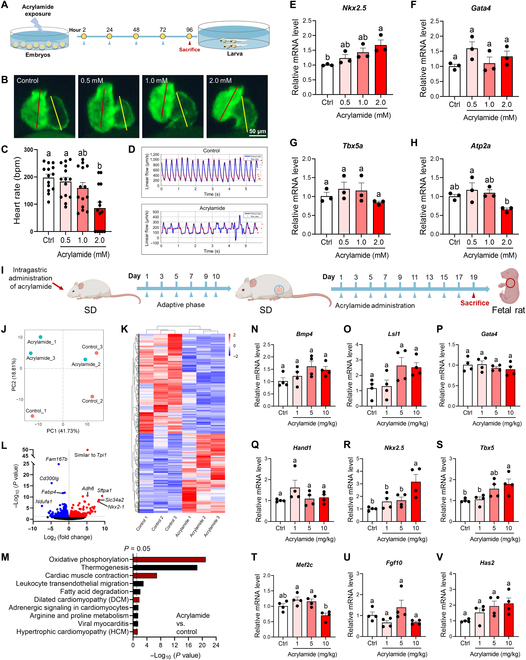Fig. 7 Acrylamide disturbs heart development during early life stage in both zebrafish embryos and rat embryos. (A) Experimental design: embryos exposed to acrylamide (0.5, 1.0, and 2.0 mM) from 2 to 96 hpf. (B) Representative fluorescence microscopy images of Tg(cmlc2: GFP) zebrafish embryos with green fluorescent protein specifically expressed in the myocardial cells. Embryos at 2 hpf were exposed to acrylamide (0.5, 1.0, and 2.0 mM) for 4 d. (C) Heart rates were measured in zebrafish (2 hpf) treated with acrylamide for 4 d (n = 20 per group). (D) Blood flow dynamics map in control and acrylamide-treated (2.0 mM) zebrafish. (E to H) Relative mRNA expression of cardiac-development-related genes in control and acrylamide-treated zebrafish (n = 3 per group). (I) Experimental design: pregnant rat exposed to acrylamide (1, 5, and 10 mg/kg·bw per day) for 19 d. (J) PCA scores plots based on RNA-seq data of hearts from rat embryos exposed to acrylamide (10 mg/kg·bw per day) (n = 3 per group). (K) Cluster analysis and (L) volcano plot of differentially expressed genes based on RNA-seq analysis. (M) KEGG analysis of RNA-seq data. (N to V) Relative mRNA levels of cardiac-development-related genes in control and acrylamide-treated rat embryos (n = 4 per group). Data are presented as the means ± SEM. Significance was calculated using one-way ANOVA with Tukey’s post hoc test; groups labeled with different letters differed significantly (P < 0.05).
Image
Figure Caption
Figure Data
Acknowledgments
This image is the copyrighted work of the attributed author or publisher, and
ZFIN has permission only to display this image to its users.
Additional permissions should be obtained from the applicable author or publisher of the image.
Full text @ Research (Wash D C)

